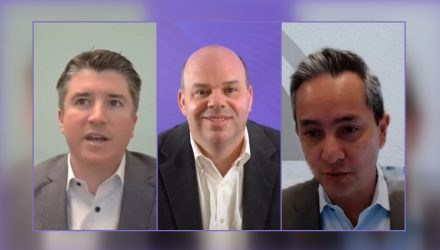A changing rate narrative now leaves advisors weighing the costs and benefits of taking on additional interest rate risk. Mark Cintolo of Natixis Investment Managers and Dominic Nolan of Aristotle Funds joined VettaFi’s Todd Rosenbluth to discuss rate risk in the recent Fixed Income Symposium.
Mark Cintolo, CFA, CAIA, VP, and portfolio consultant at Natixis, explained that the firm expects two rate cuts this year. He cited the increasing divergence of CPI and core PCE as a primary reason for cuts later this year. Core PCE is a primary inflation measure that the Fed uses when considering rates.
“At a high level, the market tends to focus a little bit too much on the exact number and the month of the first cut,” Cintolo explained. “The point in our mind is that we don’t have broad-based inflation reacceleration.” Instead, inflation remains constrained to specific areas, which doesn’t lend itself to rate hikes, according to Cintolo.
Using Duration to Capture Historic Yield Opportunities
According to a poll conducted during the webcast, it creates an environment in which advisors are currently taking on less duration than the broad benchmark. However, Cintolo believes investors should look to increase duration, given the yield opportunities and potential for improved stock/bond correlations.
“The real yield that’s available today is really attractive relative to history,” he said. Locking in a 10-year Treasury at 4.6% in an environment of 2.5% inflation allows investors to capture a 2% yield risk-free. “That’s a yield that we haven’t really seen since before the global financial crisis.”
Natixis offers a variety of actively managed funds with strategies that weigh potential growth and inflation trajectories. By determining higher and lower probability outcomes compared to the market, the portfolios tilt to express those views. The current outlook favors rate cuts in the next six to 12 months and, therefore, tilts toward increased duration.
Natixis offers a range of funds within the intermediate duration class, where the firm sees strong opportunity. These include the Loomis Sayles Core Plus Bond Fund (NERYX), the Loomis Sayles Investment Grade Bond Fund (LSIIX), and the Oakmark Bond Fund (OAKCX).
“If you’ve got another yield-like environment like last year, you’re going to make 5%,” Cintolo added.
Why You Shouldn’t Overlook Credit When Considering Rate Risk
Dominic Nolan, CFA, CEO of Aristotle Investment Services, advisor to Aristotle Funds, believes the Fed wants to cut rates but is bound by its 2% target.
“My concern is, post-COVID, obviously with all the stimulus during the pandemic, I think inflation targets should be readjusted,” Nolan explained. “To me, it’s a matter of how flexible the Fed is willing to be if inflation remains above the 2%.”
Aristotle Investment Services brings active management and fundamental investing to its lineup. The firm focuses on credit opportunities, which Nolan defines as the best asset class within fixed income.
“Credit vol [volatility]has actually been very underappreciated,” he said. “It’s actually been less volatile than rate vol. In our opinion, we would rather increase credit risk and reduce duration risk.”
See also: “Don’t Miss out: 2024 Credit Market Opportunities“
Credit investing brings broad diversification across a spectrum of asset classes, credit qualities, fixed or floating rate, and more. The firm offers the Aristotle Strategic Income Fund (PLSFX), the Aristotle Floating Rate Income Fund (PLFDX), and the Aristotle Core Income Fund (PLIDX).
“If you look empirically, credit vol and rate vol are negatively correlationed,” Nolan explained. “You can add certain credit instruments to an investment-grade portfolio and reduce the vol, increase the yield, and that’s how we’ve positioned many of our portfolios through this cycle.”
For more news, information, and analysis, visit the Portfolio Construction Channel.

